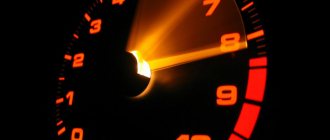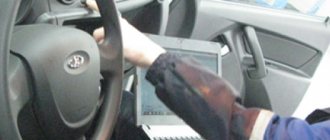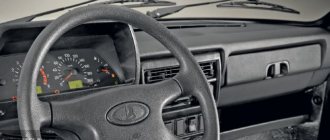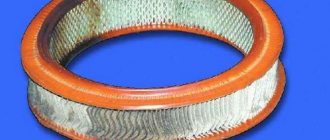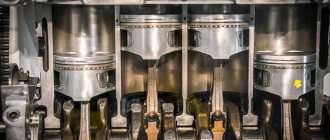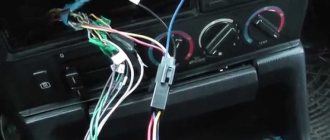This malfunction is common to engines, from old carburetor to modern injection ones; both gasoline and diesel engines suffer from it. When analyzing the possible causes of extremely unstable idling, we will take well-known VAZ models for clarity, and we will have to make an exception only for diesel engines.
Common problems on all engines at idle
The easiest way is to disassemble all common types of motors and their typical problems that lead to unstable idle operation. Sometimes the engine stalls altogether if you don’t give it more gas, which is not only inconvenient, but also unsafe.
Carburetor
A simple system, found mainly on fairly old models. Problems are most often caused by significant wear and contamination of the system, especially if it is not serviced regularly. The following breakdowns usually occur:
- The idle jet is clogged. This element has a very thin channel that easily becomes clogged with dirt. Even a grain of sand can significantly impair performance.
- Problems with fuel or air supply. Too lean a mixture provokes interruptions, which are especially noticeable at idle.
- Broken ignition settings. There can be many reasons for this; it is better to carry out the adjustment periodically.
The carburetor is a specific unit, but it is not difficult to understand if you spend a little time and study the principle of operation and the location of the main elements of the system. There may be various sensors on it that also fail.
Injector
A more advanced solution used on most modern gasoline engines. The system is an order of magnitude more reliable than the carburetor system, but malfunctions can also occur in it. Causes:
- Incorrect operation of the electronic control unit (ECU).
- Failed sensor. Usually there are several of them, and the main problem is identifying the faulty part.
- Clogged injectors. The channels have a small diameter, so they can become dirty over time.
In the injector, everything is much simpler in terms of design, but due to the large number of electronics, finding the problem can be difficult. Most often, certain models have typical faults; it is better to read information on thematic forums.
Diesel
Engines running on diesel fuel differ significantly from gasoline engines in the operating principle and design of the fuel system. Therefore, the malfunctions are different. Frequent problems:
- Problems in air and fuel lines.
- Use of low quality diesel fuel.
- Malfunction of the high pressure fuel pump.
By the way!
In winter, this may be due to freezing of the fuel line and the formation of paraffin deposits in the system.
Interruptions in the operation of carburetor and diesel engines
Why do engine speeds fluctuate in carburetor cars? Unstable activity may be caused by the following reasons:
- Failure of adjustments in idle modes.
- Failure of the carburetor engine solenoid valve.
- Excessive accumulation of combustion products in the nozzle.
Diesel engines have jumps and drops in the instrument readings during intermediate modes and when idling.
In these cases, they say that the diesel engine speed is floating. The cause is rust formed on the impeller of the high pressure fuel pump. Water contained in diesel fuel causes corrosion.
Consequences of unstable motor activity
All of the above reasons for engines running intermittently cause a number of negative consequences:
- increased consumption of gasoline or diesel fuel;
- environmental pollution with exhaust gases containing an increased percentage of harmful gases;
- increased wear of components and parts of the power unit.
Why does the car stall at idle: reasons
Experts identify several common causes that occur most often. It’s worth disassembling them to know why, when switching to neutral or idling, the engine runs poorly or even stalls:
- Electronic idle air control is found on most modern engines. The reasons for its failure may be damage, a high degree of wear, or problems with calibration.
- Dirty throttle valve or intake tract. Over time, the internal surfaces become covered with plaque, which disrupts the geometry and interferes with normal operation. The damper often gets stuck in a certain position or does not open normally, which causes problems.
- A clogged idle jet on the carburetor most often prevents the car from idling normally. But the problem may also be in other jets - air or fuel supply.
- Malfunctions or malfunctions of the fuel pump. If it does not create the necessary pressure in the system, the machine will perform poorly due to lack of fuel. And if a mechanical version is used in the car, then a membrane rupture is often to blame.
- A clogged fuel filter restricts the supply of gasoline or diesel fuel to the engine, causing it to operate incorrectly throughout the entire speed range.
- Failure or failure of the mass air flow sensor. In this case, the ECU receives incorrect information and engine operation is disrupted.
Do not ignore poor idle performance, even if the engine operates normally under load. Most often, over time, the problem develops into an even more serious one.
The relationship between the engine and car subsystems: theory
To understand the theory of the occurrence of such a situation, it is necessary to imagine how exactly the power unit of a car functions. It is worth understanding that the operation of the internal combustion engine in any mode depends on factors such as:
- fuel assembly composition;
- serviceability of the fuel injection pump and pump;
- UOZA or UOVT (for diesel engines);
- compression;
- state of spark-forming elements;
- timing belt work and much more.
Why is the injector difficult to start when cold?
If disturbances occur in one of the car engine systems, this will automatically lead to a change in the operating mode. For example, if compression decreases, the proportion of gases appearing during the process of chemical decomposition will not participate in the overall work, but will only interfere. As a result, the pressure force on the piston will decrease, the speed will drop, and the engine will stall.
The same can be said about the lubrication system and generator. If the gene voltage drops for any reason and the lubrication efficiency decreases, the engine speed drops below the required level. And vice versa, if the speed goes down, the voltage decreases. All this leads to an increase in the amount of energy required to rotate the crank.
If engine operation stabilizes after pressing the accelerator pedal, whether in idle mode or on the road, it means that there is a slight malfunction of one of the engine systems (if an injector) or a malfunction of the idle system (if a carburetor). If this does not help, the engine should be taken for professional diagnostics.
Diagnostics
It is important to understand under what conditions problems occur in order to understand where to look for them. Typical problems will not be difficult to find even for an inexperienced driver, if you remember a few simple recommendations:
- If the car stalls while driving, then starts and drives on, first check the air flow meter. Over time, it becomes covered with an oil coating and gives incorrect data; an enriched mixture is supplied to the cylinders, which floods the spark plugs at idle speed, causing the engine to stall. There is no need to rush - after a while the gasoline evaporates, the spark plugs dry out, and then the car can start. Check the fuel supply system. Sometimes the cause is a malfunction of the fuel pump.
- When the car stalls when cold, it is worth checking all elements of the air system for air leaks. Various hoses, clamps and other connections may also be to blame. The second common problem is the failure of the coolant temperature sensor; if it gives incorrect data, then on a cold engine the ECU gives a lean mixture, on which it cannot work normally. The idle speed regulator is responsible for increasing the speed while the internal combustion engine temperature has not reached the operating range. If it fails, then the normal mixture will be supplied to the cold mixture, on which the engine will not be able to operate normally.
- If the problem occurs when the engine is warm, check the intake system first. Remove the rubber corrugation and inspect the condition of the intake tract in the place where the throttle valve is installed. If the system is clean, then the throttle sensor is checked, it is this that most often provokes the problem. You must make sure that the idle speed sensor is working properly.
By the way! If you have a diagnostic connector, it is worth visiting a service station to check the system for errors. Very often, all the data about malfunctions is there, so you don’t have to look for the cause yourself.
Reasons for carbureted cars
For the carburetor, the reasons are quite simple and can be easily eliminated:
1. If the solenoid valve stops receiving power. To fix the problem, you need to check the car's power supply.
2. If the valve itself becomes unusable, the winding burns out. There is only one solution - replacing the solenoid valve.
3. The nozzle is clogged. Needs cleaning.
Having eliminated all factors of failure, you should adjust the idle speed on the carburetor. You can do this yourself or, due to lack of skill, entrust the setup to a specialist.
What to do first
Very often the car stalls due to problems not related to the fuel supply system. Especially if everything was fine before and the malfunction arose unexpectedly. In this case, remember these simple recommendations:
- First of all, make sure there is fuel in the tank.
- Check if the anti-theft system is disabled.
- Make sure the fuel pump is working properly. When you turn on the ignition, it should hum; if there are no signs of operation, it should be replaced.
- Pay attention to the engine's operation. If the speed is lower than it should be when cold, then the problem is in the idle speed control.
- When the motor operates intermittently (speeds fluctuate, excess vibration is felt, etc.), check the system for air leaks.
- Inspect all connections. Often the cause is a disconnected wire on the coil or broken contacts elsewhere.
- Check how the throttle valve moves by pulling on the actuator under the hood. If it turns with difficulty or is stuck at all, the machine will not work properly.
Another reason that may occur periodically is broken high-voltage wires. The problem is clearly manifested in damp weather, and if it’s dry outside, it may disappear.
Troubleshooting sequence
If the effect of stopping the engine at idle occurs, it is necessary to perform the following work sequentially:
- full diagnostics of the car, with decoding of all error codes;
- replacement of faulty sensors, components and modules, the fault of which is indicated by diagnostic results;
- control of fuel pressure in the rail;
- searching for the possible presence of suction in the intake system;
- washing the throttle valve assemblies and the XX regulator with a special agent;
- checking the ignition system components;
- replacing fuel and air filters;
- draining fuel and refilling with high-quality fuels and lubricants.
Source
How to fix the problem yourself
There is no universal instruction, since it all depends on the type of motor and the part that has failed or is not working correctly. But you can carry out some work that is not difficult and most often allows you to fix the problem:
- In a carburetor engine, first clean all the jets. To do this, they need to be removed and blown out. It is important to remember how many turns each element was screwed in. You can try to adjust the idle speed by tightening the corresponding jet. It is also important to check whether all components on the carburetor move; often they stick or move tightly; removal and cleaning or using a repair kit will solve the problem. At the same time, check whether the float is stuck or damaged.
- Be sure to check the intake system for air leaks. Inspect the rubber corrugation if present, pull the connections and tighten the clamps if necessary. Check for cracks in the rubber hoses.
- Remove the throttle body assembly and clean it if there is deposits on the inside walls. It is most convenient to use carburetor or brake cleaner. The spray quickly corrodes the plaque, and it is easily erased or even runs off.
- Cleaning the injectors yourself can be problematic, but you can use a special product that is added to the fuel. If the problem is minor, normal operation will be restored.
- Often the reason is broken high-voltage wires or worn-out spark plugs that do not produce a normal spark. It is best to simply replace these consumables to ensure the ignition system is working perfectly.
- It's worth checking the sensors. If they are inexpensive, it is easiest to replace them. On some models, these nodes can be cleaned to restore normal operation. It is also worth checking the flow meter, since the quality of the fuel mixture directly depends on it.
- The lambda probe is another element whose malfunction disrupts engine operation. You can find out that it is not working using computer diagnostics.
Important! If the above work does not bring results, it is better to contact specialists to conduct a more thorough check and identify why the machine is not working properly.
If your engine stalls or idles rough, it is important to identify the problem and fix it. Most often, this does not take much time and is inexpensive. The nature of the work may differ on different engines, so it is best to study the typical problems of your car so that you know what to check first.
Signs of failure in the fuel system
The presence of possible malfunctions in the operation of the vehicle’s power system can be judged by the characteristic signs of the vehicle’s behavior on the road:
- Failure - while pressing the gas pedal, the car continues to move at the same speed (or deceleration) for a short period of time (from 1 to 30 seconds), and only after a while begins to pick up speed;
- A jerk is reminiscent of a failure, but it is more short-lived;
- Rocking - periodic failures;
- Twitching is several jerks that follow each other;
- Sluggish acceleration is a reduced rate of increase in vehicle speed.
In addition, you can judge the presence of malfunctions in the engine power supply system by the following signs:
- Increased fuel consumption;
- The engine does not start;
- Idle speed is reduced or increased;
- Difficulty in starting a hot/cold engine;
- Difficult operation of the car engine in cold mode.
The main role is played by the technical condition of the car engine.
Shift in gas distribution phases, wear on the camshaft cams, incorrect adjustment of heat clearances, reduced or uneven compression in the cylinders, as well as burnt valves significantly reduce the vehicle’s power, cause vibration and increase fuel consumption.
The carburetor and its malfunctions also play an important role. Let's look at the most common carburetor malfunctions using Solex as an example. How to properly clean, check and adjust the carburetor, using the VAZ 2109 as an example, is described in the article. So.
If the cylinder-piston group is worn out, then crankcase gases, oil vapors and tarry substances can enter the carburetor area, clog the filter element of the filter, and also settle on the jets and other elements of the carburetor, thereby disrupting the operation of the engine.
Diesel engines
Commonrail controls the injection nozzles via an electronic signal from the engine control unit. In this system, malfunctions of the fuel lines (leaks) are possible, which leads to airing of the system and, as a consequence, poor starting of the car and unstable idling. To eliminate it, it is necessary to replace the defective fuel line and bleed the system to remove air.
In rare cases, a malfunction is caused by objects getting into the air filter housing, as a result of which the air supply to the cylinders is cut off and operation is unstable at XX speed and, as a result, the engine stalls. Also, if several fuel injectors malfunction, the engine will stall at low speeds. To eliminate this, it is worth checking the fuel injectors for performance on a specialized stand and, if necessary, replacing worn parts.
The pump-injector system is characterized by a mechanical injector control drive. The symptoms and methods for eliminating defects are identical to CommonRail, there are slight differences in the defects. In this system, there is a possibility of a malfunction of the mechanical drive of several injectors, which will also affect the operation of the internal combustion engine. The solution is to replace the drive.
Reasons for fuel-injected cars
In this case, it will be more difficult to find the cause, since the fuel supply is controlled electronically. It is worth noting that the injector itself is not a purely electronic installation, but a complex - an electronic-mechanical system. If a breakdown occurs with electronics, then it is better to entrust this matter to a specialist. And if problems occur with the mechanical part, then you can fix them yourself.
Idle speed begins to “float” when an uneven amount of air enters the system. This may be due to:
1. Malfunction of the air supply sensor.
2. Deformation of rubber tubes. To find the required tubes, you need to start the engine and pinch each one in turn until the engine stops.
3. Malfunction of the ignition module.
4. Unadjusted valves.
The main causes of carburetor contamination
The main enemy of the carburetor system is low-quality gasoline. It can contain a huge amount of different sizes of rubbish. But debris can get into the fuel already “on board”, for example from many years of sediment at the bottom of the gas tank, which rises every time you refuel at a service station.
Of course, there is a fuel filter in front of the carburetor, but people often forget to change it on time, which reduces its protective and throughput capabilities. The same applies to the fuel pump. As a rule, it has a filter mesh. The condition of such places needs to be checked. It is quite possible that the pump was also clogged, which is why the engine began to stall.
Old hoses and other rubber parts in the fuel system are another danger on the path of gasoline to the combustion chambers. If such parts have not been changed for 15-20 years, then there is no point in counting on their reliability. The rubber cracks on the outside, but the worst thing happens inside - the structure of the inner walls is destroyed under the influence of the chemical components of gasoline and pieces of hoses move through the channels. In this case, the source of debris may be located behind the filter.
It is not so rare for the fuel pump diaphragm to fail. Long before its “death,” this element is capable of systematically polluting channels with products of material destruction.
Is the carburetor to blame?
If the engine is carburetor, then 90% of such malfunctions occur due to the carburetor. The simplest reason is that it is clogged. Therefore, cleaning and flushing the carburetor is a periodic maintenance.
Any microscopic speck that has somehow passed through the filters can seriously complicate the operation of the engine and create many problems for both novice drivers and professionals.

